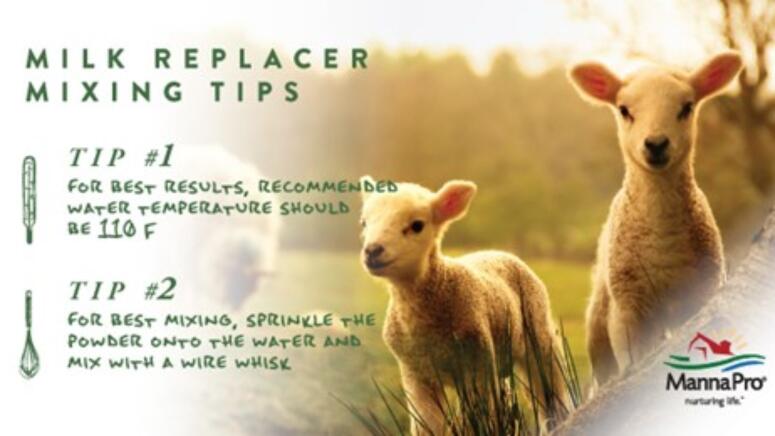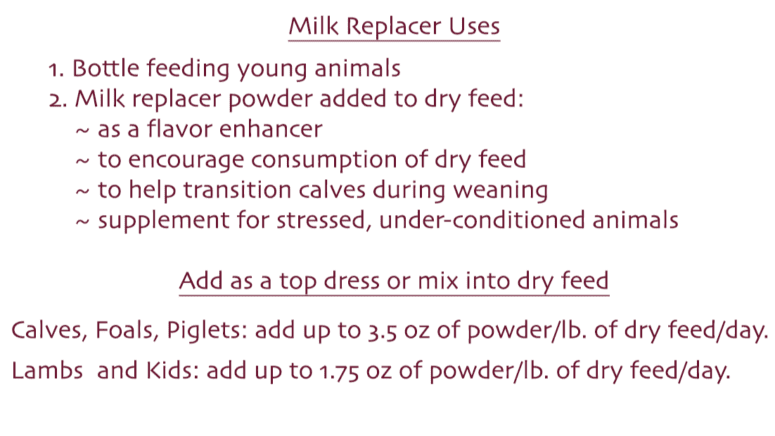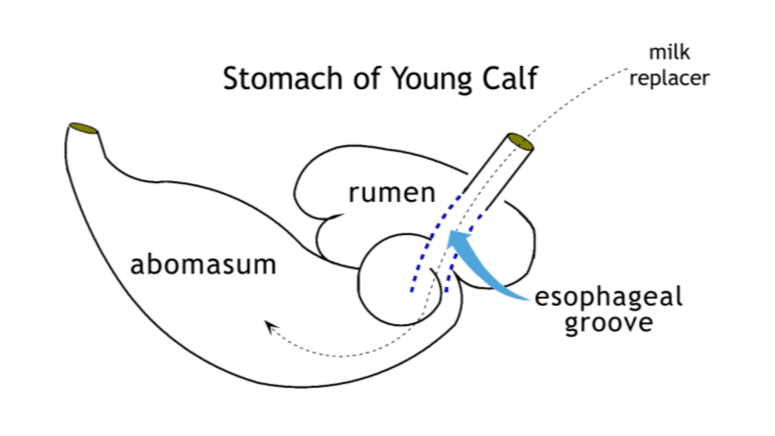
Milk replacers play a vital role in a young animal's life, replacing all or a portion of the high-quality proteins found in mother’s milk. They provide highly digestible proteins and energy sources as well as additional vitamins and minerals to support immune system, tissue, body weight and bone growth.
Proper mixing and feeding ensure that all ingredients go into solution and help maximize digestibility and health benefits. Warm water temperature and mixing technique are important steps in that process.
Beyond Bottle Feeding
Milk Replacer for calves, goat kids and other baby farm animals can also be fed as a Meal Topper. You can add a replacement powder directly to dry grain feed as a flavor enhancer to encourage consumption, to facilitate weaning from milk replacer and to supplement nutrients to stressed, under-conditioned or any animal that needs a boost.
Top dressing milk replacer is an excellent way to supply high quality minerals, vitamins, protein and energy to your growing animals. You can add it as a top-dressing or mix it in and incorporate it into the feed. It’s important to empty feed buckets daily for maximum palatability and to prevent spoilage.

Sheep are a special case when it comes to feeding and supplementation. Copper is an important mineral and must be provided in the diet for wool production, bone growth and for immune function.
Unlike other livestock, sheep accumulate excess dietary copper in their body. Typically it builds up slowly over time and is slowly excreted. If copper accumulation gets too high, the stored copper is suddenly released into the bloodstream, and is usually fatal.
As daily copper intake rises above 25 ppm (parts per million) per day, the likelihood of excess accumulation increases. Be sure to consider the copper in mineral supplements, forages and other feeds before adding more supplements. The amount of copper provided by 1.75 ounces of a typical milk replacer is only about 1 ppm. For young lambs drinking milk replacer and eating dry feed formulated for sheep, top dressing lamb milk replacer powder should not be a problem.
Don’t Forget Water
When encouraging calves, lambs and kids to consume dry feed, pay special attention to their water requirement. In addition to the water provided by milk or milk replacer they need a separate source of water to support dry feed intake so they develop into functional ruminants by weaning time.
Cattle, sheep and goats are ruminant animals, or grazing herbivores with four-chamber stomachs. Interestingly, these animals aren't born with multiple stomach chambers. When a calf, lamb or kid drinks milk or livestock milk replacer, muscles in its esophagus contract to form an esophageal groove.
This groove prevents the liquid from entering the rumen and moves it directly to the abomasum for digestion. The abomasum is called the “true” stomach and functions much like ours. The esophageal groove can last up to 10 minutes after drinking milk.

Dry feed and water, on the other hand, take a different path to digestion. They do not cause an esophageal groove to form so they drop directly into the rumen. Providing access to drinking water is an important part of encouraging dry feed intake, digestion and rumen development. By providing water free-choice to young animals throughout the pre-weaning period you can have a big impact on feed intake and average daily gain.
For dehydrated calves, foals, kids and other baby animals, consider adding Manna Pro® Bounce Back® into their feed routines. This electrolyte supplement was formulated to re-hydrate baby animals. Check it out here!
Can I Feed Milk Replacer to My Dog & Cat?
It’s common knowledge that most well-fed dogs and cats enjoy milk and dairy products. It’s also common knowledge that feeding too much milk can cause digestive upsets such as bloating, diarrhea or vomiting.
The issue may be their ability to digest lactose, a milk sugar and energy source. The lactase enzyme is required to digest lactose, and as puppies and kittens grow, lactase production decreases. By 12 weeks of age, they may have lost as much as 90% of their lactose digesting ability.
But as it turns out, adult animals vary widely in lactase production and some maintain high values throughout their lives. Animal breed and other genetic factors may influence how tolerant your adult dog or cat is to lactose.
Nurse All® multi-species milk replacer has more protein, more energy from fat and less lactose than other milk replacer formulas, providing easier nutrition for dogs and cats. The amount you feed can have a big effect.
If your pet can’t drink a bowl of milk without experiencing problems, they may do fine with a smaller portion or some milk replacer sprinkled on their food. And they may really appreciate that special treat.
Manna Pro's Milk Replacers, Colostrum Supplements and More
Whether bottle-feeding milk replacer powder or top dressing for nutritional support, Manna Pro has the right milk replacers for your growing needs. Manna Pro Lamb, Kid, and Calf milk replacers are specially designed for your animals, or expand your options with a multi-species milk replacer like Nurse All and Unimilk. Nurse All provides additional protein and energy for nine species of young animals and contains probiotics for a healthy gut right from the start.
Cow Milk Replacers
- Colostro-Fix® Powder. Milk replacer for a calf under 24 hours old featuring essential globulin protein.
- Rite Start™ Complete Powder: bovine colostrum supplementation for baby cows.
Goat Milk Replacers
- Kid Colostrum Powder. Enhance the growth of baby goats with Manna Pro's Kid Colostrum, an easy-to-mix milk replacer for goat kids. This highly digestible powder promotes healthy, robust development of kids.
- Goat Kid Milk Replacer. Made with probiotics, this milk replacer for goats with probiotics is great for gut health and digestion. Includes protein for optimal growth and development.
Sheep Milk Replacers
- Lamb Milk Replacer. This sheep milk replacer for lambs features probiotics and protein for digestion and growth support.
Multi-Species Milk Replacers
- Calf-Manna®: this multi-species supplement provides essential nutrients for the whole farm.
- Unimilk® Multi-Species Milk Replacer with Probiotics: featuring probiotics and protein, feed this milk replacer to a wide range of animals including horses, cows, dogs, goats and more.
- Advance® Multi-Species Milk Replacer: for kittens, puppies, horses, cows and more.
- Nurse All® Multi-Species Milk Replacer with Probiotics
- Colostrum Supplement: works for calves, goat kids, lambs, foals, piglets, llamas, alpacas, puppies and kittens.
Featured Products

